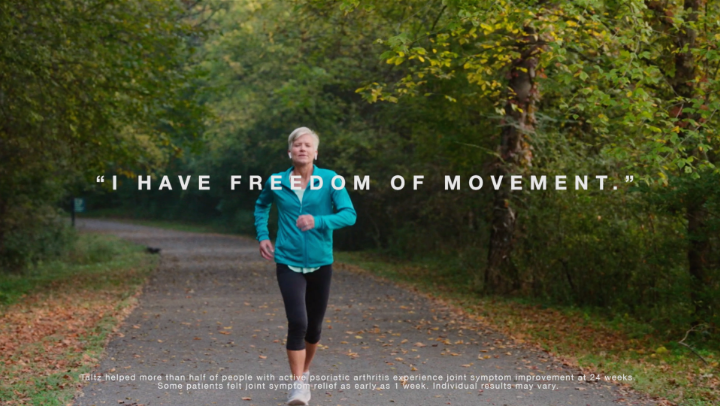Patient Story
Consider the possibilities with Taltz
Think Taltz for your patients with
psoriatic arthritis (PsA)
Michelle’s Story (PsA)
Michelle* has psoriatic arthritis. She needs a treatment that offers powerful and consistent efficacy over time.
Daniel’s Story (axSpA)
Daniel* has axSpA. He needs a treatment that provides powerful and consistent efficacy, regardless of diagnosis (AS or nr-axSpA).
Consider the possibilities with Taltz
“My treatment doesn’t seem to be working consistently.”
Eager to get relief from:
- Joint pain
- Bothersome skin plaques
- Presenting with pain and swelling in her ligaments and tendons
- Experiences a loss of efficacy on her current treatment
She needs a treatment that offers powerful and consistent efficacy over time.
Consider Taltz for patients like Michelle
*Hypothetical patient profile.
SPIRIT-P1 and -P2: See ACR20/50/70 response rates at week 24
FOR PATIENTS WITH ACTIVE PSORIATIC ARTHRITIS
Powerful joint symptom results, regardless of TNFi experience1-3
Primary endpoint=ACR20 response at week 24.3
Inadequate responders (<20% improvement in tender and in swollen joint counts) at week 16 were analyzed as nonresponders after week 16 until the primary endpoint.3
NRI of ITT population through week 24.
TNFi=tumor necrosis factor inhibitor; ACR20/50/70=American College of Rheumatology 20%/50%/70% response; NRI=nonresponder imputation; ITT=intent-to-treat.
SELECT IMPORTANT SAFETY INFORMATION: INFECTIONSTaltz may increase the risk of infection. In clinical trials of adult patients with plaque psoriasis, the Taltz group had a higher rate of infections than the placebo group (27% vs 23%). A similar increase in risk of infection was seen in placebo-controlled trials of adult patients with psoriatic arthritis, ankylosing spondylitis, non-radiographic axial spondyloarthritis, and pediatric patients with plaque psoriasis. Serious infections have occurred. Instruct patients to seek medical advice if signs or symptoms of clinically important chronic or acute infection occur. If a serious infection develops, discontinue Taltz until the infection resolves.
SPIRIT-P1 and -P2: See PASI 75/90/100 & sPGA 0,1 response rates at week 12
FOR PATIENTS WITH ACTIVE PSORIATIC ARTHRITIS
Taltz improved psoriatic skin lesions1-5
In SPIRIT-P1, among patients with sPGA ≥3 at baseline (Taltz 80 mg every 4 weeks n=52; placebo n=41), 75% of patients receiving Taltz achieved sPGA 0,1 at week 12 vs 7% of patients who received placebo. Additionally, 31% of patients receiving Taltz achieved sPGA 0 at week 12 vs 2% for placebo.
In SPIRIT-P2, among patients with sPGA ≥3 at baseline (Taltz 80 mg every 4 weeks n=60, placebo n=55), 63% of patients taking Taltz achieved sPGA 0,1 at week 12 vs 4% of patients who received placebo. Additionally, 23% of patients receiving Taltz achieved sPGA 0 vs 2% for placebo.
Inadequate responders (<20% improvement in tender and in swollen joint counts) at week 16 were analyzed as nonresponders after week 16 until the primary endpoint.1
Primary endpoint=ACR20 at week 24.
PASI=Psoriasis Area Severity Index; PASI 75/90/100=75%/90%/100% improvement from baseline in PASI criteria; PsA=psoriatic arthritis; PsO=psoriasis; BSA=body surface area; NRI=nonresponder imputation; TNFi=tumor necrosis factor inhibitor; ITT=intent-to-treat; sPGA=static Physician’s Global Assessment; ACR20=American College of Rheumatology 20% response.
SELECT IMPORTANT SAFETY INFORMATION: PRE-TREATMENT EVALUATION FOR TUBERCULOSISEvaluate patients for tuberculosis (TB) infection prior to initiating treatment with Taltz. Do not administer to patients with active TB infection. Initiate treatment of latent TB prior to administering Taltz. Closely monitor patients receiving Taltz for signs and symptoms of active TB during and after treatment.
SPIRIT-H2H: See simultaneous achievement of ACR50 and PASI 100 response rates through week 52
FOR BIOLOGIC-NAIVE PATIENTS WITH PSORIATIC ARTHRITIS
Superiority vs Humira at week 24: Simultaneous achievement of ACR50 and PASI 100 at week 24, with consistency at week 526,7
Primary endpoint=simultaneous achievement of ACR50 and PASI 100 at week 24.
All patients had BSA ≥3%; patients with BSA ≥10%, PASI ≥12, sPGA ≥3 followed the dosing for moderate to severe PsO.7
ACR50=American College of Rheumatology 50% response; PASI=Psoriasis Area Severity Index; PASI 100=100% improvement from baseline in PASI criteria; NRI=nonresponder imputation; BSA=body surface area; sPGA=static Physician’s Global Assessment; PsO=psoriasis.
SELECT IMPORTANT SAFETY INFORMATION: HYPERSENSITIVITYSerious hypersensitivity reactions, including angioedema and urticaria (each ≤0.1%), occurred in the Taltz group in clinical trials. Anaphylaxis, including cases leading to hospitalization, has been reported in post-marketing use with Taltz. If a serious hypersensitivity reaction occurs, discontinue Taltz immediately and initiate appropriate therapy.
SPIRIT-P1 and -P2: See complete resolution of enthesitis data at week 24
FOR ADULT PATIENTS WITH PSORIATIC ARTHRITIS
Taltz showed improvement in patients with preexisting enthesitis1,2,4,8
Primary endpoint=ACR20 response at week 24.
LEI=Leeds Enthesitis Index; NRI=nonresponder imputation; TNFi=tumor necrosis factor inhibitor; IR=inadequate responder; ACR20=American College of Rheumatology 20% response.
SELECT IMPORTANT SAFETY INFORMATION: INFLAMMATORY BOWEL DISEASEPatients treated with Taltz may be at an increased risk of inflammatory bowel disease. In clinical trials, Crohn’s disease and ulcerative colitis, including exacerbations, occurred at a greater frequency in the Taltz group than the placebo group. During Taltz treatment, monitor patients for onset or exacerbation of inflammatory bowel disease and if IBD occurs, discontinue Taltz and initiate appropriate medical management.
SPIRIT-P2: See complete resolution of enthesitis data through year 3
FOR TNFi-EXPERIENCED PATIENTS WITH PSORIATIC ARTHRITIS
Complete resolution of enthesitis was maintained in the majority of patients through year 31,3,8-12
In SPIRIT-P2 (TNFi-experienced), in an mNRI analysis of patients receiving Taltz 80 mg every 4 weeks (n=68), 48% of patients achieved LEI=0 at week 52, 46% at week 108 and 38% at week 156.12
mNRI analysis, a preferred method for analyzing long-term efficacy, imputes missing data due to study drug (eg, inadequate response, adverse event, lack of efficacy), as nonresponse; whereas missing data due to other reasons (eg, missed visits, lost to follow-up) are included as predicted values based on statistical modeling of observed data.
Primary endpoint=ACR20 response at week 24.2
The uncontrolled extension period of the study has limitations (eg, no placebo comparisons, patients remaining in the study may be those with better results).
TNFi=tumor necrosis factor inhibitor; LEI=Leeds Enethesitis Index; mNRI=modified nonresponder imputation; ACR20=American College of Rheumatology 20% response.
SELECT IMPORTANT SAFETY INFORMATION: IMMUNIZATIONSPrior to initiating Taltz, consider completion of all age-appropriate immunizations according to current immunization guidelines. Avoid use of live vaccines in patients treated with Taltz.
SPIRIT-P1: See consistent joint symptom results sustained for 3 years
FOR BIOLOGIC-NAIVE PATIENTS WITH PSORIATIC ARTHRITIS
Consistent joint symptom results sustained for 3 years10,13
In an mNRI analysis of patients receiving Taltz, ACR20 results were 76% at week 52, 71% at week 108, and 70% at week 156. ACR50 results were 60% at week 52, 52% at week 108, and 52% at week 156. ACR70 results were 40% at week 52, 30% at week 108, and 33% at week 156.
mNRI of ITT population through week 156.
mNRI, a preferred method for analyzing long-term efficacy, imputes missing data due to study drug (eg, inadequate response, adverse event, lack of efficacy) as nonresponse; whereas missing data due to other reasons (eg, missed visits, lost to follow-up) is included as a predicted value based on statistical modeling of observed data.
The uncontrolled extension period of the study has limitations (eg, no placebo comparisons, patients remaining in the study may be those with better results).
IRs (<20% improvement in tender and in swollen joint counts) at week 16 were analyzed as nonresponders after week 16 until the primary endpoint.
Primary endpoint=ACR20 response at week 24.
ACR20/50/70=American College of Rheumatology 20%/50%/70% response; mNRI=modified nonresponder imputation; ITT=intent-to-treat; IR=inadequate responder.
SELECT IMPORTANT SAFETY INFORMATION: ADVERSE REACTIONS Most common adverse reactions (≥1%) associated with Taltz treatment are injection site reactions, upper respiratory tract infections, nausea, and tinea infections. Overall, the safety profiles observed in adult patients with psoriatic arthritis, ankylosing spondylitis, non-radiographic axial spondyloarthritis, and pediatric patients with plaque psoriasis were consistent with the safety profile in adult patients with plaque psoriasis, with the exception of influenza and conjunctivitis in psoriatic arthritis, and conjunctivitis, influenza, and urticaria in pediatric psoriasis.
![]()
References: 1. Mease PJ, van der Heijde D, Ritchlin CT, et al; SPIRIT-P1 Study Group. Ixekizumab, an interleukin-17A specific monoclonal antibody, for the treatment of biologic-naive patients with active psoriatic arthritis: results from the 24-week randomised, double-blind, placebo-controlled and active (adalimumab)-controlled period of the phase III trial SPIRIT-P1. Ann Rheum Dis. 2017;76:79-87. 2. Nash P, Kirkham B, Okada M, et al; SPIRIT-P2 Study Group. Ixekizumab for the treatment of patients with active psoriatic arthritis and an inadequate response to tumour necrosis factor inhibitors: results from the 24-week randomised, double-blind, placebo-controlled period of the SPIRIT-P2 phase 3 trial. Lancet. 2017;389:2317-2327. 3. Taltz [package insert]. Indianapolis, IN: Lilly USA, LLC. 4. Nash P, Kirkham B, Okada M, et al; SPIRIT-P2 Study Group. Ixekizumab for the treatment of patients with active psoriatic arthritis and an inadequate response to tumour necrosis factor inhibitors: results from the 24-week randomised, double-blind, placebo-controlled period of the SPIRIT-P2 phase 3 trial. Supplementary material. Lancet. 2017;389:2317-2327. 5. Data on file. Lilly USA, LLC. TAL20171127A. 6. Data on file. Lilly USA, LLC. DOF-IX-US-0190. 7. Mease PJ, Smolen JS, Behrens F, et al; SPIRIT H2H Study Group. A head-to-head comparison of the efficacy and safety of ixekizumab and adalimumab in biological-naïve patients with active psoriatic arthritis: 24-week results of a randomised, open-label, blinded-assessor trial. Ann Rheum Dis. 2020;79:123-131. 8. Data on File. Lilly USA, LLC. DOF-IX-US-0127. 9. Data on file. Lilly USA, LLC. DOF-IX-US-0277. 10. Data on file. Lilly USA, LLC. DOF-IX-US-0151. 11. Chandran V, van der Heijde D, Fleischmann RM, et al. Ixekizumab treatment of biologic-naïve patients with active psoriatic arthritis: 3-year results from a phase III clinical trial (SPIRIT-P1). Rheumatology (Oxford). 2020;59:2774-2784. 12. Orbai AM, Gratacós J, Turkiewicz A, et al. Efficacy and safety of ixekizumab in patients with psoriatic arthritis and inadequate response to TNF inhibitors: 3-year follow-up (SPIRIT-P2). Rheumatol Ther. 2021;8:199-217. 13. Data on file. Lilly USA, LLC. DOF-IX-US-0013.



